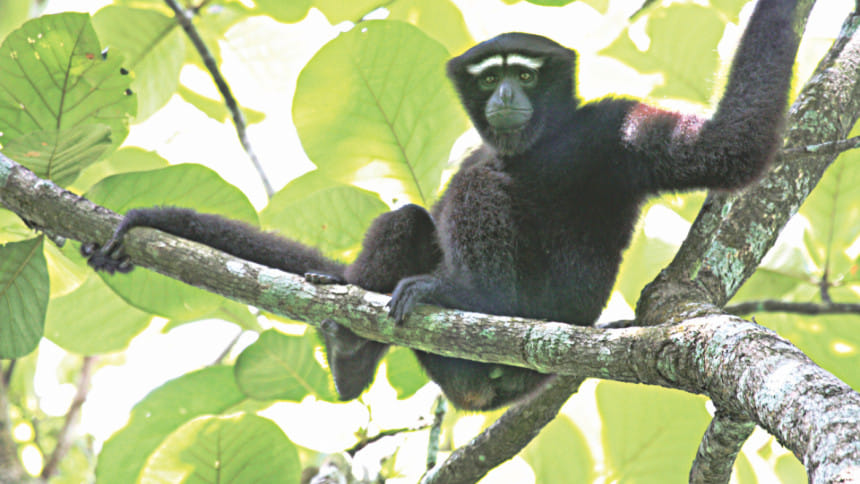Nature Quest: Hoolock -- our acrobats atop forest canopies

We have a unique animal in Dhaka Zoo. If you are passing by it anytime during the day or residing within two kilometres of it, you are not going to miss out on the unusual ear-deafening duetting sound coming from the zoo. These very high pitched hoo-uk-hoo-hoo-ho, hook kooo reverberates across the zoo lake, tall canopy of the botanical gardens and through the neighbourhood.
If you want to hear the similar sounds in nature, Lawachhara forest is possibly the best. When you would first hear such a resonating sound in Lawachhara, you are bound to be afraid because the forest is generally silent barring occasional chit-chats of birds and monotonous music produced by crickets and cicadas. Such a sound creates terror in our mind. It soon raises hairs in our body. Adrenaline runs high.
Walking through the short trail by the Lawachhara Forest Rest House, many tourists get startled from the species-specific voice notes produced by an animal so rare in Bangladesh. It is Hoolock Gibbon. The Bengali name is Ulluk that is sometimes also called Ban Manush.
Bangladesh is home for a good number of non-human primates. These include lone ape species, I mean tail-less higher ones that include Greater Apes represented by the Bonobo, Chimpanzee, Orangutan and Gorilla as well as Lesser Apes represented only by Gibbons. In Asia, we have Gibbons and Orangutan while the African continent has Gorilla, Chimpanzee and Bonobo. The last one has brain faculty little less than that of human beings.
Hoolock is the only no-human primate of Bangladesh vis-à-vis the Indian subcontinent having no tail. The species in the recent past has been divided into two -- the Western and Eastern Hoolocks. We have in our side only the Western Hoolock (Hoolock hoolock). This particular species extends its range from the hilly forests of Bangladesh in Sylhet and Chittagong divisions to Assam in India and parts of Myanmar.
The Eastern Hoolock (Hoolock leuconedys) lives in the remote eastern tip of Assam to parts of Myanmar and south-west side of the Yunnan province in China. However, bulk of the gibbons, 17 species, live in areas spreading from Myanmar to Indonesia.
If you are patient, can wait for hours and not afraid of loneliness in the middle of a jungle, you are likely to be rewarded by a high-flying visit by an acrobat brachiating through the topmost canopy of the most deciduous forests. In this case, the best place for an encounter with our greatest acrobat -- the hoolock -- is our popular tourist destination -- the Lawachhara. It sits next to the tea town of Srimangal and is cut across by the Dhaka-Sylhet rail track as well as a highway. The forest is encircled by scores of tea gardens, undulating hills with or without tall trees and many tiny-mini chhara.
Many Lawachhara visitors get disappointed as they do neither see nor hear the hoolocks when they have had a short sojourn there. But many are lucky as they not only hear the loud hoots of the hoolocks, but see them from close quarters as I see in some Facebook postings. To see or not to encounter it is a matter of sheer luck!
Of all the non-human primates we have, the hoolock is the most intelligent. This gibbon and all the others in the group have forearms almost double the size of the hand legs. These are so well adapted for brachiating that in a single swing it can cover a distance of over 15 metres. Its feet and hands are so well equipped that it can leap for eight metres or so and can run through the canopies at a speed of nearly 55 km an hour. It is a wonderful feat for an arboreal mammal and the fastest of all animals moving through canopies. It can walk on branches, climb easily and walk overland vertically on hind legs when balancing the body with the near upright hands.
Among all the Apes, only gibbons including our hoolocks form pair bonds where partners are together until one is dead when the living partner would recruit a new one. Unlike other great apes, gibbons do not know how to build nests on tree tops by collecting branches for sleep or rest. However, they choose high perching positions on heavy branches and tree trunks sheltered by leaves of the canopy.

 For all latest news, follow The Daily Star's Google News channel.
For all latest news, follow The Daily Star's Google News channel. 



Comments